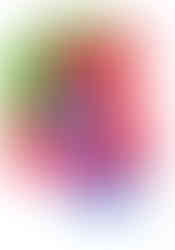
That is a scribble drawing. The scribble drawing changed my life. Here are the simple steps I follow:
1. Gather art materials (paper, pencil, oil pastels)
2. Close your eyes and scribble on the paper
3. Open your eyes and turn the paper this way and that
4. What do you see?
5. Colour or draw what you see in the scribble
Scribbling for therapy
Step 4 above references Mala Betensky’s What Do You See? Phenomenology of Therapeutic Art Expression. Betensky argues for the significance of scribble drawing in art therapy and phenomenological reflection. Through the act and interpretation of scribbling, a person can access their intuitive and spontaneous creativity, their thoughts, emotions, and experiences. The scribble fosters introspection and, like much art therapy, bypasses the verbal to get to the not-easily-expressible.
It is an ambiguous, polyvalent product, meaning that the scribble can hold multiple interpretations. When a person makes spontaneous marks on the page, and then reflects on those marks, the person explores the meanings that emerge for them in the scribble. This can lead to insights about themselves and their experiences in the world.
Scribbling for art’s sake
Scribble drawing is an art form.
Joan Miró and Paul Klee, both Surrealists, are among the artists who incorporated scribbles into their work. Scribble art is a sort of ‘automatic’ art. Surrealists believed it could disrupt the usual ways of seeing and of thinking, freeing them from rational constraints. Through it, they accessed mystery and ambiguity, their spontaneous and irrational thoughts and fears.
We are not all Mirós and Klees. What is the art of the scribble for us?
‘I can’t draw’ is a common sentiment. ‘I’m no good at art.’ Such thoughts can stand between us and the enjoyable practice of art-making. The scribble bypasses those complaints; there is no need for artistic capacity, for perspective, anatomy, or composition. The value of the art-making is as much if not more in the process than in the product. The image can remain as abstract or ill-shaped as you like.
Scribbling for spirituality
The scribble drawing can easily be incorporated into spiritual practice. The focus on scribbling and interpretation brings one into the present moment, and so may be thought of as a technique for mindfulness. It can encourage meaningful connection with self, with divinity, or with process, and can express deep and valuable truths. The very act of art-making, using the body to make marks on a page, the feeling of the oil pastel laying colour on the paper, brings the body and the mind together into an integrated whole. Through this act, too, we might slip into a state of flow, surely a spiritual experience.
Within the Jewish tradition, the scribble drawing may be used as a type of hitbodedut. This practice involves ‘separating yourself’ and communicating spontaneously with the divine. Scribble drawing, like hitbodedut, encourages the participant to engage in spontaneous dialogue. The participant might use the scribble to dialogue with their most authentic self, or with divinity, however they conceive of it.
Below are some examples of the not-so-humble scribble within my own psychospiritual practice.































































